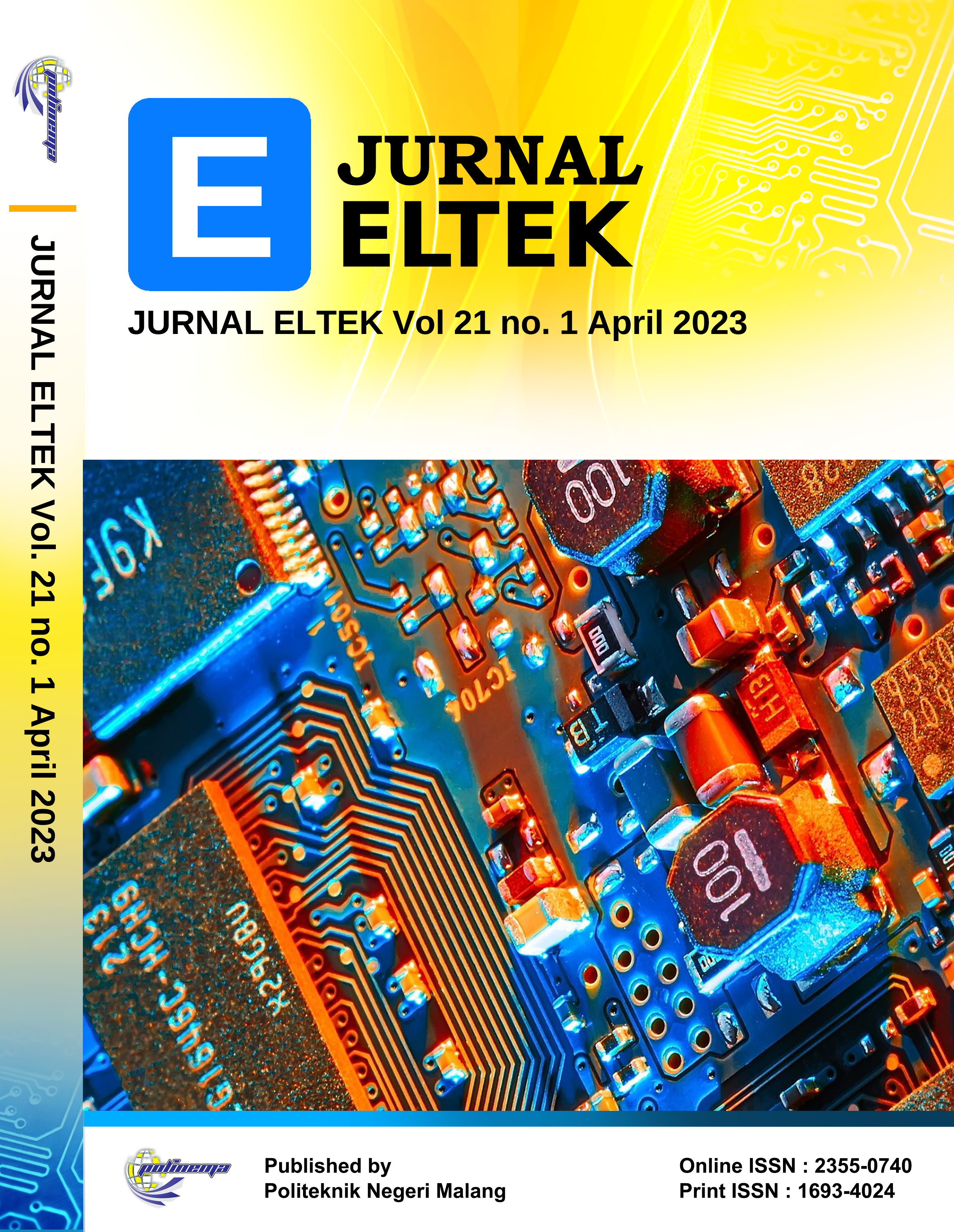Implementasi desain Smart Stick untuk anak tunanetra berbasis GPS terintegrasi dengan smartphone
DOI:
https://doi.org/10.33795/eltek.v21i1.369Keywords:
Anak Tunanetra, Arduino, Huruf Braille, Sensor GPS, Sensor UltrasonikAbstract
Dewasa ini, banyak anak yang memiliki kebutuhan khusus dalam hidupnya. Anak-anak berkebutuhan khusus membutuhkan bantuan teknologi untuk menemukan mereka jika mereka kehilangan kontak dengan keluarga mereka. Masalahnya jika tidak memiliki alat akan sulit untuk mengenali lokasi dimana mereka berada. Penelitian ini bertujuan untuk membuat smart stick (tongkat pintar) untuk anak tunanetra. Tongkat pintar ini memiliki banyak fitur dalam teknologi disini sensor ultrasonik dan sensor GPS (Global Positioning System). Hasil luaran sensor ultrasonik dan sensor GPS diproses oleh arduino. Sensor ultrasonik dapat mendeteksi rintangan di sekitar dan memberikan peringatan berupa suara peringatan. Tongkat pintar ini juga dilengkapi dengan sistem keamanan di bagian dalam dan luar yang dilengkapi dengan alat pelacak dan notifikasi. Apabila tombol pada Tongkat ditekan maka GPS akan mengambil nilai koordinat dan mengirimkannya melalui SMS (Short Message System). Sistem keamanan ini bertujuan agar anak tunanetra merasa lebih aman saat menggunakan tongkat karena adanya alat pendeteksi rintangan dan alat pelacak. Tongkat pintar ini dilengkapi dengan huruf braille di tombol tekannya untuk memudahkan anak tunanetra memahami fungsi dari tombol pada smart stick. Hasil dari penelitian ini telah lolos uji, dengan terpenuhinya fitur-fitur yang direncanakan dalam pengujian. Tongkat pintar dapat digunakan oleh anak-anak tunanetra di lokasi mereka yang hilang.
ABSTRACT
Nowdays, there are many children who have special need in their life. The children who have special needs in sight need some help with technology. It will be very difficult to find them if they have lost contact with their family. The problem is difficult to recognize the location where they are. This research has the objective to make smart stick for blind children. This smart stick has many features in technologies. It has sensor ultrasonic sensor and GPS sensor. The Ultrasonic Sensor and GPS Sensor are processed by Arduino. The Ultrasonic sensor can detect the obstacles around and give warning in the form of a warning sound. This smart stick is also equipped with a security system on the inside and outside equipped with tracking devices and notifications. Beside that, If the button of the stick is pressed, the GPS will take the coordinate value and send it via SMS (Short Message System). This security system aims to make blind children feel safer when using the stick because of the obstacle detector and tracking device. This smart stick is equipped with braille word in their push button. The result from this research is success in testing. The smart stick can be used by blind children in their lost location.
References
B. P. S. K. Sidoarjo, "Badan Pusat Statistik Kabupaten Sidoarjo. https://sidoarjokab.bps.go.id/statictable/2019/08/12/88/penyandang-cacat-menurut-kecamatan-dan-jenis-cacat-2018.html," 12 08 2019.
D. R. S. d. P. D. Sucipto A., "Gerak Robot Berkaki Dua menggunakan ROS dan RViz sebagai Visualisasi Interaktif," ELKOMIKA: Jurnal Teknik Energi Elektrik, Teknik Telekomunikasi, & Teknik Elektronika, vol. 9, pp. 48-57, 2021.
A. D. S. &. P. D. Sucipto, "Dynamic Stability Walking On Inclined Surface For" T-FloW" Humanoid Robot Using Design Pattern Step," in In 2019 International Electronics Symposium (IES) , Bali, September, 2019.
K. N. K. R. P. M. H. d. R. A. Shah M., "A Cost-Effective Smart Walking Stick for Visually Impaired People," in 6th International Conference on Communication and Electronics Systems (ICCES), Coimbatre, India, 2021.
d. G. A. Agrawal M. P., "Smart Stick for the Blind and Visually Impaired People," in Second International Conference on Intentive Communication and Computational Technologies (ICICCT), Coimbatore, India, 2018.
A. P. d. R. P. Bharatia D., "Smart Electronic Stick for Visually Impaired using Android Application and Google’s Cloud Vision," in Global Conference for Advancement in Technology (CGAT), Bangalore, India,, Oktober 18-20, 2019.
S. A. S. A. R. M. E. L. I. J. D. R. F. F. K. &. T. N. R. Y. Wulandari, "Inovasi Hipnoterapi Berbasis Aplikasi," Journal of Electrical Engineering and Computer (JEECOM), vol. 4, no. 2, pp. 57-61, 2022.
N. A. M. A. d. M. S. A. F, "Stik Pintar Respon Cepat Efektif untuk Tunanetra," no. doi: 10.15224/978-1-63248-043-9-29, pp. 5-11, 2015.
A. R.D, "Smartbag Dengan Sistem Keamanan Berbasis Arduino Sensor PIR, dan GPS Melalui SMS," in Pros. Ind. Res. Kerja, Bandung, 2020.
K. A., "Alat Bantu Jalan Sensorik bagi Tunanetra," Inklusi, vol. 6, no. 2, p. 285, 2019.
Downloads
Published
How to Cite
Issue
Section
License
Copyright (c) 2023 Agus Priyo Utomo, Adi Sucipto, Sholihah Ayu Wulandari, Ahmad Fahriyannur Rosyady, Mochammad Enrique Lazuardi, Dyiono Dyiono

This work is licensed under a Creative Commons Attribution-ShareAlike 4.0 International License.







